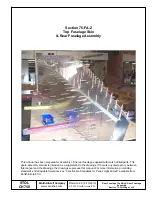
8
FOSTER AREA NAVIGATION
PILOT'S OPERATING HANDBOOK
TYPE 511)
SUPPLEMENT
c.
Excess RANGE to Waypoint (6) -- This would be any value
over 199 NM. (A check of aircraft position relative to the
VORTAC and Waypoint will detect and verify this condition.)
2.
Missing DME Signal Display -- This will show as "00.0" in the
RANGE NM digital display (6) when the VOR/DME button (2) is
held in. The missing DME signal is then the reason for the FLAG
condition. (If valid VOR and DME data is displayed, then another
cause must be sought.)
3.
Temporary Display of Unchanging Random Digits in the BEAR-
ING and RANGE Windows (2 & 6) at Time of Initial Turn-ON --
Such a condition is caused by a random interpretation of the micro
processor cycle. The RNAV 511 will Flag this malfunction by a
complete blanking of all display functions. The pilot can reset the
micro processor cycle by turning the RNAV OFF and then ON.
WAYPOINT PROGRAMMING
1.
Using a VFR Sectional or other appropriate maps -- DETERMINE
distance and bearing for desired waypoint(s) from appropriate
VOR/DME stations.
2.
VHF Navigation Receiver -- ON (When installed with DME 190,
RNAV 511 is connected to the Nav 1 Rcvr. When installed with the
400 DME, RNAV 511 may be connected to either the Nav 1 or Nav 2
Rcvr.) and channeled to the desired VORTAC.
3.
DME ON/OFF Switch -- ON.
4.
DME Remote Channeling Selector on DME 190 Selector -- SET to
REM position on DME 190.
5.
DME Mode Selector on 400 DME -- SET TO desired NAV 1 or NAV 2
position on 400 DME.
NOTE
RNAV and HOLD positions on the 400 DME Mode Selector
are not used with this installation. RNAV is automatically
channeled to the selected Nav receiver.
6.
GS/ TTS Selector Switch (on 400 DME) -- SET as desired. (Will only
display ground speed component or time-to-station at that speed to
the selected VOR --not the waypoint.)
7.
RADIAL and DISTANCE Thumbwheels -- SET to first waypoint
RADIAL and DISTANCE. (Typically, the first waypoint is set into
the left side set of thumbwheels.)
8.
RADIAL and DISTANCE Thumbwheels -- SET to second waypoint
RADIAL and DISTANCE. (Typically, the second waypoint is set
into the right set of thumbwheels.)
9.
Left WPT Pushbutton Switch -- PUSH in.
a.
First waypoint RADIAL and DISTANCE are placed in unit as a
waypoint.
6
1 July 1979
8
PILOT'S OPERATING HANDBOOK
FOSTER AREA NAVIGATION
SUPPLEMENT
(TYPE 511)
10.
RNAV BEARING Readout -- OBSERVE readout for magnetic
BEARING to waypoint.
11.
RNAV RANGE Readout -- OBSERVE readout of first waypoint
distance.
12.
TEST Pushbutton -- PRESS and observe that the desired BEAR-
ING and RANGE readouts of the waypoint thumbwheel settings
are displayed.
a.
BEARING Display Readout -- DISPLAYS readout of first
waypoint bearing.
b.
RANGE Display Readout -- DISPLAYS readout of first way-
point distance.
13.
DG or HSI -- CONTROL AIRCRAFT as required to maintain
desired track to or from waypoint.
NOTE
Due to wind drift, it will be necessary to fly a few degrees
plus or minus the calculated BEARING readout in order to
maintain the desired BEARING readout on the computer.
14.
VOR/DME Pushbutton -- PRESS at anytime to observe the radial
and DME distance from the VORTAC associated with the way-
point.
15.
Upon Waypoint Passage -- CHECK or SELECT next desired
waypoint's VORTAC frequency on the selected Nav receiver and
then PRESS next WPT Pushbutton in and repeat steps 9 through 12
to proceed to next waypoint which was dialed in the right set of
thumbwheels.
NOTE
Waypoint passage will begin to be reflected on the RNAV
BEARING display about 1.5 NM from the waypoint. Way-
point passage will be reflected by a rapid change of
BEARING displays. Therefore, the pilot should fly the
established inbound predetermined DG heading until
waypoint passage has occurred or until the next waypoint
is selected.
16.
Left Hand RADIAL and DISTANCE Thumbwheels -- SET to next
waypoint RADIAL and DISTANCE.
NOTE
As first waypoint is reached, it can be replaced with the
next waypoint RADIAL and DISTANCE. Then a new
1 July 1979
7










































